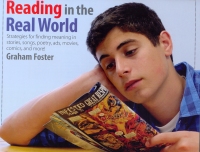| ________________
CM . . . . Volume XVIII Number 40 . . . . June 15, 2012
excerpt:
While addressed directly to students, this 32 page flip booklet would be most useful for teachers planning reading encounters with their students. The flip book format, use of colour blocking, charts, white space and a detailed index assist readers in quickly finding desired information. A strength of this booklet is the repeated references to a “comprehensive sense of meaning” which is reflected in the excerpt above and in each of the seven strategies that are briefly explained through the use of definitions and examples from real texts. The student poem “Foreigner” is interpreted for meaning to illustrate the first strategy to focus and determine the meaning, the fourth strategy of interpreting the ending or final chunk of text, the fifth strategy of orally presenting a text, and the sixth strategy of transforming a print text to a video format. Each of these interpretations contains enough detail to guide and model students and novice teachers to develop their own interpretations. The shooting script is presented in a chart to show both the video camera shots and the audio for each shot. The appropriate film vocabulary is also modelled in the example.Another strength is the choice of real world texts (song lyrics, ads, movies, comics) that students would encounter of their own free will, unlike the mandatory read of a teacher chosen class novel. Strategy three, a brief but comprehensive and useful before, during and after list of reading strategies and related questions, ends with suggestions students could choose from to write in their reading logs. Strategies two and seven focus on writing techniques and could benefit from a stronger link. After strategically using one poem to illustrate four strategies as mentioned above, these two related writing sections would be stronger if the “use cartoons to learn writing techniques” section provided examples of the same techniques that are highlighted in the second “focus on technique” section. For a booklet of this length, it is not expected that all possible techniques be included. Therefore, perhaps choosing 10 literary techniques to define in the glossary on page 7; using these same 10 on the following two pages that discuss techniques used in real literary texts; and finally choosing again from these 10 to illustrate techniques used in comics, would provide more focus, a deeper understanding of these 10 literary techniques, and a strong scaffold for students to explore more techniques on their own. Another concern is the inaccuracy of the definition of “rhythm,” which Foster writes is “the speed at which a text, often a poem, is read” (p. 7). Speed of reading is the pace, while rhythm is the pattern of repetition of sounds to create a beat or flow. It is much more than speed, although one could say the song has a slow or fast rhythmic beat. Another suggested improvement is the definition of conflict. Foster defines conflict as “the problem a character must deal with; sometimes a physical obstacle, sometimes an internal problem” (p. 7). Lukins (A Critical Handbook of Children’s Literature. 5th ed. NY: HarperCollins. 1995) succinctly defines conflict as tension or opposition between forces in the plot, and identifies four types of conflict: within a character, and/or between characters, nature or society. This definition includes Foster’s external/internal component, but expands and defines the external in ways students can easily identify. Reading in the Real World includes a page on supporting student readers, suggesting strategies which align with best practice in reading instruction. Many of the suggestions refer to collecting various exemplars of texts and interpretations which are important for modelling and conferring with students. Caution is needed with the suggested use of a timer, which may certainly encourage students to make effective use of the next 15 or 20 minutes of their reading time, but to have students also count up the number of pages they have read (p. 15) with no reference to adjusting their reading rate to match text difficulty might well promote bad teaching practice instead of the student’s effective use of class time. Five black line masters could be used to assist students in tracking their use of reading strategies, to create their reading profile, list their top five text choices, and keep an independent reading record. Graham Foster is the author of a companion Pembroke flip book Twelve Sides to Your Story, as well as many other language arts related books. He has worked as a language arts supervisor and conducts professional development workshops. His focus is on the practical aspects of language arts and this booklet provides many such examples. Recommended with reservations. Betty Klassen teaches in the Middle Years B. Ed. program at the Faculty of Education, the University of Manitoba, in Winnipeg, MB.
To comment
on this title or this review, send mail to cm@umanitoba.ca.
Copyright © the Manitoba Library Association. Reproduction for personal
use is permitted only if this copyright notice is maintained. Any
other reproduction is prohibited without permission.
NEXT REVIEW |
TABLE OF CONTENTS FOR THIS ISSUE
- June 15, 2012.
AUTHORS |
TITLES |
MEDIA REVIEWS |
PROFILES |
BACK ISSUES |
SEARCH |
CMARCHIVE |
HOME |
||||||
